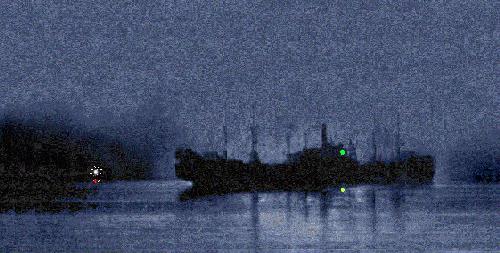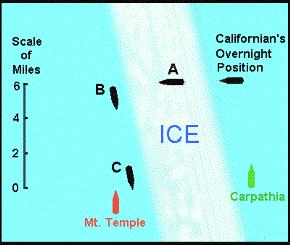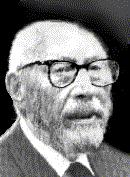

At 10:30 p.m. on the night of April 14, 1912 the Leyland liner Californian, westbound for Boston, stopped on the eastern edge of a huge icefield in mid-Atlantic. Roughly half an hour later Captain Stanley Lord and Third Officer Charles Victor Groves noticed what Groves at first thought was a star rising over the eastern horizon, although continued observation showed the "star" to be the masthead light of an approaching ship. The unknown vessel continued her westward approach, and Groves soon saw that she was a big, well-lit passenger liner. At 11:40 p.m., however, the big liner stopped half a dozen miles south-southeast of the Californian and seemed to put out her lights. The darkened newcomer lay there quietly, pointed almost directly toward the Californian and showing the latter vessel her red port sidelight and a greatly foreshortened view of her port side.
At midnight Third Officer Groves went off duty and was replaced by Second Officer Herbert Stone and Apprentice James Gibson; in looking toward the horizon Stone and Gibson could both see what appeared to be a small, poorly-lit vessel lying five to seven miles south-southeast of the Californian. Shortly thereafter, however, both men were surprised to see that the nearby vessel had begun sending up rockets which burst into white stars directly above her. (Gibson even saw a flash of light on the vessel's deck when one of the rockets was fired.) The Apprentice and the Second Officer continued to observe the nearby vessel and eventually noticed that she "didn't look right," and that she seemed to "have a big side out of the water."

As time went on the nearby vessel seemed to move laterally along the Californian's horizon (undoubtedly caused by Californian's slow, drifting rotation to starboard), and Second Officer Stone came to the mistaken conclusion that the nearby vessel had begun steaming away from the Californian. Apprentice Gibson doubted this, however, testifying later that the vessel had never showed her stern light to the Californian; besides, even though Stone (later) speculated that the observed rockets might actually have come from a ship situated BEYOND the nearby vessel, he admitted that the rockets always stayed directly over the nearby ship - the one he mistakenly believed was steaming away.
At around 2:20 a.m. the rocket-firing ship disappeared from the Californian's view, and Second Officer Stone believed she had steamed out of sight.

At 3:20 a.m. Stone and Gibson noticed additional rockets being fired low down on the southern horizon. At 4 a.m. Chief Officer George Stewart came on duty and pointed out to Second Officer Stone that a ship was now clearly visible half a dozen miles south-southeast of the Californian - a ship that Stone never saw arrive there. The new arrival was situated in pretty much the same location where the rocket-firing ship had been before she vanished at 2:20 a.m.

At around 5 a.m., as day began to break, Captain Lord reappeared on the Californian's bridge and, shortly thereafter, caused his wireless operator to be awakened. Marconi operator Cyril Evans manned his instrument and was soon apprised of the fact that the Titanic had gone down during the night. At 6 a.m. the Californian began steaming westward through the icefield toward the Titanic's (incorrectly reported) CQD position.
At 6 a.m. - the same time that Californian commenced steaming westward through the icefield - the Mt. Temple was situated directly west of the rescue ship Carpathia (which was engaged in picking up the Titanic's lifeboats.) While looking toward the north the Mt. Temple's master, Captain James Moore, clearly saw Californian in the middle of her westward traverse of the icefield just half a dozen miles north of the Carpathia.
At 6:20 a.m., after clearing the western edge of the icefield, the Californian turned and began steaming southward at full speed.
At 6:25 a.m. the Californian's wireless operator notified the Virginian that his vessel was already within sight of the Carpathia and the Titanic's lifeboats.
At 6:50 a.m. Third Officer Groves returned to the Californian's bridge and saw that Californian (after steaming southward about six miles) was already directly west of the Carpathia and the disaster site (which was on the eastern side of the icefield - the same side from which the Californian had commenced her crossing just fifty minutes before.) The Mt. Temple was visible a mile ahead (further south) of the Californian.
At 7:45 a.m. (according to Third Officer Groves' watch) Californian reached the Carpathia and the disaster site after crossing once again to the eastern side of the icefield.
Within hours the whole world would be shocked by the news that the "unsinkable" White Star liner Titanic had struck an iceberg and gone down in mid-Atlantic. During succeeding weeks official hearings in Britain and America concluded that the Californian had been situated a mere half-dozen miles north of the sinking Titanic that night and had (1) watched her strike the iceberg at 11:40 p.m.; (2) watched her send up a series of distress rockets; (3) watched her founder at 2:20 a.m.; and (4) undoubtedly observed later rockets fired by the rescue ship Carpathia as she approached the disaster site. The Californian's Captain Lord denied these charges, claiming that his vessel had been situated about nineteen miles north of (and beyond visual rage of) the Titanic while the latter was sinking.
And thus was born the "Californian Controversy."

Although most of the above information about Californian's movements is based on testimony given at the American and British Titanic inquiries, the reader will be surprised to learn that very little of this information appears in books documenting the Titanic disaster and the so-called "Californian incident." Instead, a latter-day cottage industry has arisen in which certain revisionist writers have devoted themselves to "proving" that the Californian was indeed nineteen miles (instead of six miles) north of the disaster site during the entire period the Titanic was sinking.
Foremost among these revisionist writers is Leslie Harrison, whose book "A Titanic Myth" is usually thought to be an objective examination of the Californian incident as well as a convincing defense of Captain Lord. In reality, though, the so-called "strength" of Harrison's position is due solely to the fact that Harrison fails to present his readers with the most damning testimony against the Californian that was provided by several key witnesses at the two government inquiries. In other words, the only reason that the "Californian controversy" exists at all is because Leslie Harrison and other Lordite writers resort to such extreme SELECTIVITY in choosing which evidence to present to their readers; the fact that the "Lord is innocent" scenario receives so much publicity is due to the simple fact that Harrison and his associates are very vocal and are often in a privileged position to promote their viewpoint in the printed media.

The present author never used to be very interested in the Californian incident - that is, until Leslie Harrison's "A Titanic Myth" was published. Long familiarity with the testimony given at the two government inquiries caused the present author to be utterly appalled by Harrison's selectivity in deciding which evidence to include in his book and which evidence to "ignore" - and thus keep his readers in ignorance of.
Standard historical research procedures require that historians acknowledge the existence of evidence which counters the premise of their written works; legitimate historians are also duty bound to document the reasons why they regard such conflicting evidence to be untrustworthy. Leslie Harrison, however, does not make even the slightest attempt to do this in "A Titanic Myth": indeed, Harrison's book merely IGNORES the existence of a great body of evidence that counters its author's point of view. Needless to say, such behavior is not in keeping with guidelines set up by generations of legitimate historians who wish their published works to be taken seriously.
At any rate, Leslie Harrison's blatant disregard for standard research procedures has, in effect, enabled him to "alter history" by exposing his readers to a carefully-selected (but very limited) body of evidence that tends to support his own beliefs about the Californian. Harrison's determination to go to such great lengths to promote his own viewpoint is fascinating - so much so that, in late 1994, the present author began corresponding with Harrison to try and determine why he consistently "ignores" the very existence of so much evidence that so clearly documents the proximity of the Californian to the Titanic while the latter vessel was sinking.
The reader might benefit from the opportunity to study the above-mentioned correspondence which passed between the present author and Leslie Harrison; such study will give the reader a feel for the "give and take" that took place as well as permit the reader to assess Harrison's willingness (or lack of same) to address the crucial evidence that he deliberately chose to omit from his book.
It is hoped that the reader will find the following information instructive.